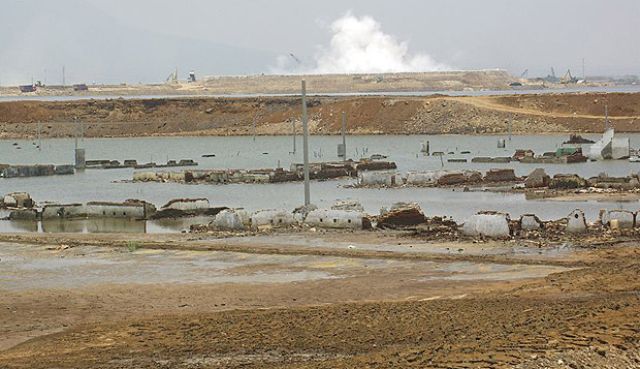
Australian energy company Santos has met determined resistance to its coal seam gas operations in Australia. It is less well known that Santos was one of the companies responsible for a monumental environmental catastrophe in Indonesia in 2006. The accident drowned villages in the Porong subdistrict of Sidoarjo in mud, and displaced up to 50,000 people.
Santos has an 18% share in the operator responsible for the disaster, PT Lapindo Brantas (Lapindo). Other shareholders include the Bakrie Group and Medco. Santos and Lapindo have denied responsibility. They blame the mud on a nearby earthquake.
But a 2007 report in the Geological Society of America’s journal, GSA Today, argued that the disaster happened because Lapindo failed to install sufficient casing around its gas well.
A Lapindo drill penetrated an underground system of mud and carbonated water. After mud started to seep into the well, Lapindo inserted cement plugs to contain it. The pressurised mud forced its way to the surface and caused a gas explosion at a nearby site.
Huge volumes of mud erupted to the surface on May 26, 2006 — about 150,000 cubic metres a day, creating the world’s largest mud volcano. Two more mud-flows erupted soon after, but ceased by June 2006. However the first mud volcano is still spewing mud at a reduced rate (60,000 cubic metres a day) and is expected to continue for the next 26 years. Mud is still emerging from new points, as are new gas leaks.
Santos was not involved in Lapindo’s day-to-day operations at the site when the incident occurred. However, Lapindo has said it consulted Santos about all drilling procedures, and provided it with regular reports. Santos also apparently had at least one officer on the ground at the time, according to Australian Sidoarjo Assistance Project correspondence with Santos.
The Australian Sidoarjo Assistance Project said 11 villages, extensive farmlands, 30 factories and 33 schools were destroyed by the mud flow. Estimates of people displaced range from 15,000 to 50,000.
The mud contains toxic chemicals such as hydrogen sulphide, hydrocarbons and ammonia, and is saline. The mud flow also destroyed the aquaculture industry in the region.
The victims of the Lapindo disaster have been only partially compensated. Many had to live in refugee camps, subsisting on an inadequate diet, provided largely by NGOs. Rates of depression and malnutrition are high. Victims also suffer from health problems caused by the toxins in the mud and gas.

Santos says it aims to “improve the quality of life of local people through initiatives that boost health, education and incomes” in East Java. This kind of rhetoric should be familiar to Australian audiences that have seen Santos ads on television. In Australia as in Indonesia, Santos says one thing and does another.
On Australian TV the actor-farmer says Santos is “always welcome on my property” because “they look after the people, and they look after the land”. Meanwhile, Australian farmers are blockading their properties to stop Santos damaging the aquifers they depend on.
Significantly, the ongoing Sidoarjo disaster was caused by gas exploration. Mining and energy companies tell concerned residents that environmental concerns are irrelevant at the exploratory stage. Yet if 50,000 people can be displaced by exploration, how bad could things get once extraction starts?
Events in Australia also show the dangers of exploration, like the pumping of 1.2 million litres of diesel to frack the Whicher Range Gas Field in WA in 2004 as part of “exploratory” activities.
Energy companies clearly aren’t exploring because they are curious. At the very least, exploration allows them to get a foot in the door.
The Lapindo victims have stood up for themselves. They protested in their thousands for several years after the catastrophe. Even in May 2010 a protest was attended by several hundred people in several different cities. Organisations fighting for justice include the Indonesian Forum for the Environment (Walhi), Institute Hijau Indonesia, Women’s Solidarity and the People’s Coalition for Justice in Fisheries (Kiara).
International solidarity has largely been missing from this campaign, however. There has been no public solidarity campaign in Australia to hold Santos to account, although the efforts of the Australian National University-based Australian Sidoarjo Assistance project to provide aid to the victims should be commended.
Bizarrely, in May last year Indonesian President Susilo Bambang Yudhoyono suggested the mud flow could become a tourist attraction. Although an environmental disaster would hardly seem an ideal tourist destination, the mud flow nevertheless attracts about 100-300 visitors a day. The visitors are Indonesians and foreigners. It isn’t tourism, but concern. It is a sign that people care.
Now is the time to step up the international solidarity. While Australian farmers are battling Santos over coal seam gas, we can empathise with Santos’ victims in Indonesia.